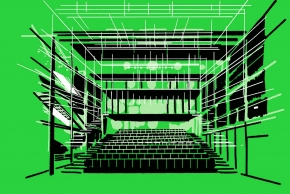The purpose of the Scène de recherche is to welcome, support and develop dialogues between art and science, research and creation.
Some explanations are necessary. On the topic of combining art and science, physicist and philosopher of science Jean-Marc Lévy-Leblond made two crucial statements over ten years ago. “I have no nostalgia for the lost unity between art and science,” and “if science wishes to be a part of culture, it cannot do so by recuperating or reasoning with artistic creation; and if the arts wish to take part in a world dominated by technology and science, they cannot do so by plagiarizing them or becoming subordinate to them.” The relevance of these statements remains intact to this day. The Scène de recherche is therefore not interested in fusing art and science, nor does it aim to make art an instrument of science (or vice-versa).
Concerning the concept of “research-creation” philosopher Carole Talon-Hugo recently took a stance against “epistemological anarchism,” which she deemed a danger for artists “dressed like researchers.” The Scène de Recherche does not wish to replace the researcher with the artist, nor does it defend researchers dressed like artists.
After issuing these warnings, must we conclude that artistic activity is impervious to scientific research? We do not think so. The Scène de recherche is a unique space in which the many forms taken by the relationship between art and science can be explored while avoiding aforementioned risks.
First, it must be said that artistic and scientific activities have research in common. Though their material and epistemological conditions can be extremely different, parallels can be traced between their methods and processes. This is true for visual arts, design, and drama–the latter having become fond of “laboratories” and experiments for over a century. Though they do not perfectly correspond, artists and scientists often look alike and, to cite Claude Lévi-Strauss, “the artist is the heir of the scholar and the tinkerer: with artisanal means, he creates material objects which are also objects of knowledge.”
Mediating a dialogue between artists and scientists can have many benefits: when in contact with scientists, aesthetics are renewed, ground themselves in informed analysis, and go beyond imaginary representations of science and innovation; when in contact with artists, scientists see their work in a new light, and are made to reconsider their questions or the meaning of their results. Some anthropologists of science call this process a “profane catalyst.” By accelerating reflection or even making it possible, the Scène de recherche seeks to be such a catalyst.
By experiencing works of art, the audience can both enjoy and learn about a research topic; this is not, however, the complete extent of these encounters. Theater can get a hold of scholarly content to turn it into sensory experiences, the stage becoming “a unique and singular space for thought experiences to take place” according to researchers Marion Boudier and Chloé Déchery.
Aesthetic experiences have their own cognitive potential. To make ideas appear on stage allows the audience to reflect on their meaning, their applications and their implications. An artistic point of view on science can be appreciative or critical, but above all, it must compel the audience to ask questions. This cannot be reduced to a mere didactic method. Dialogue is not agreement, and it is most fruitful when no consensus is found. The Scène de recherche is open to experimentation in the way John Cage meant it: “an experimental action [...] the outcome of which is not foreseen.”
This season offers a new spin on the different forms taken by dialogue between artists and scientists.
Take part in developing the Scène de recherche by making a donation to support artists in creation-research residency, outreach to all publics and the purchase of equipement for the Comedia dell’Arte. Learn more.
